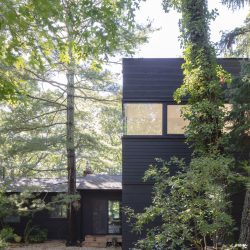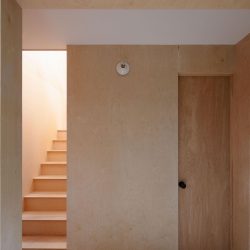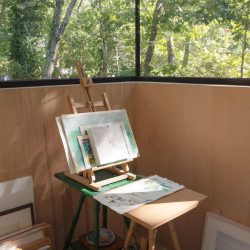
Worrell Yeung . photos: © Naho Kubota
Brooklyn-based architecture practice Worrell Yeung has designed Springs Artist Studio, a two-story addition to an existing home in the hamlet of the Springs on the South Fork of Long Island for a painter/creative director and a florist with a robust collection of art and objects. Situated among the dense tree canopies, the new 800-square-foot building houses a painting studio on the upper floor and an exhibition space/single-car garage and powder room on the ground level.
Constrained by the neighborhood’s strict zoning rules and the unique site’s environmental sensitivities, Worrell Yeung delicately inserted the structure within the smallest footprint possible, and without removing any existing trees, minimizing the impact on the pristine landscape. Veiled through a wooded filter and only slightly visible from the road, the studio very gradually emerges upon approach, quietly appearing through the surrounding landscape.
The new addition is attached to the existing home by a fully glazed connector, bringing the natural surroundings of the lush wooden landscape inside while providing a moment of respite between home and studio/work environments. The plywood-clad foyer features a plywood staircase which leads to the upstairs painting studio. Installed above the staircase is a vintage David Weeks chandelier that has been recently refurbished.
Upstairs, a 360 degree panorama of four-foot-tall ribbon windows gaze onto dense tree canopies and, to the West, Hog Creek and osprey nests. Natural light streams in, while unique views appear from each direction, framed by unobstructed glass corners. To achieve the continuous ribbon window that enwraps the studio space, Worrell Yeung worked with Silman Structural Engineers to create small steel columns to match window mullions with steel rod cross bracing, providing lateral support. The effect creates a strong panoramic view and the feeling that the roof structure is floating.
Birch Plywood boards extend across the studio floor and four feet up the walls to the start of the windows. The plywood finish of the studio’s surfaces is efficient and utilitarian , while also adding natural warmth to the space. Plywood also clads the peninsula of cabinet space that protrudes from the wall, just in front of the staircase landing. This storage space, as well as the sink on top, allows the artist to store his materials and dilute his paints. The walls and vaulted ceiling above the ribbon window are painted white to reflect light around the space, making it an ideal locale for painting and exhibiting artwork. Four minimal uplights offer diffuse illumination and complement the natural light flooding throughout the space.
_




























